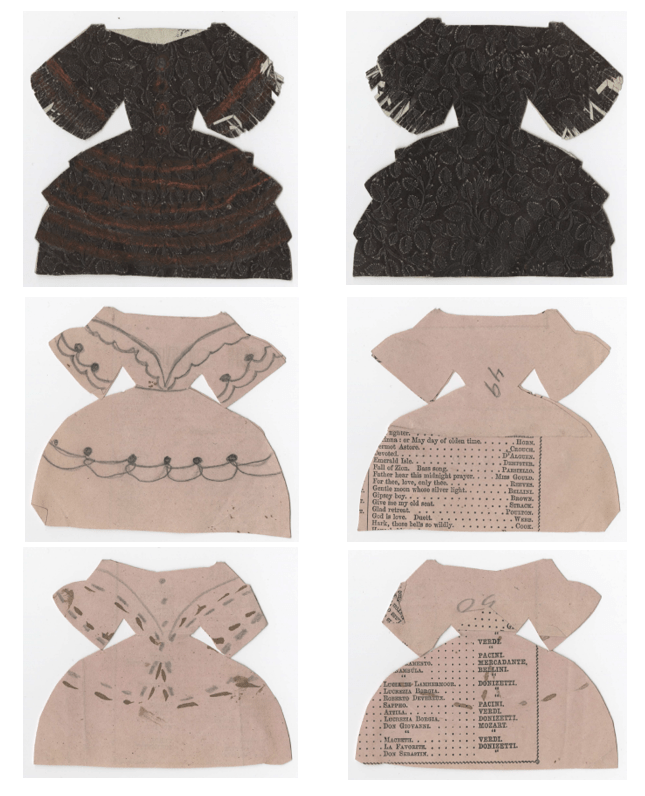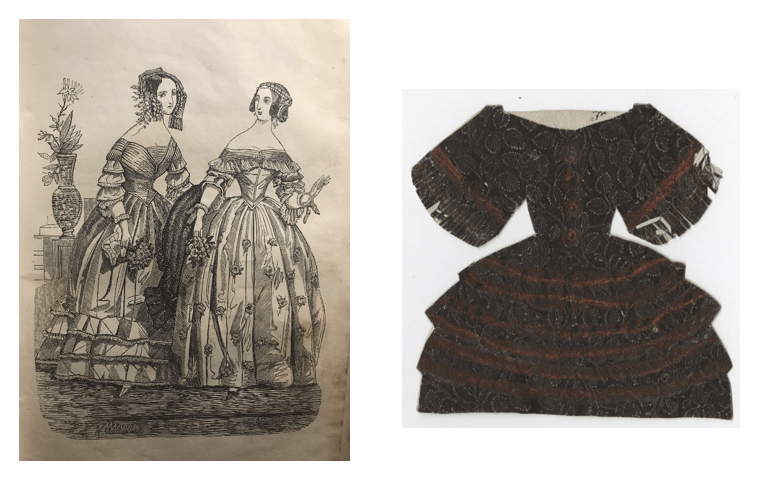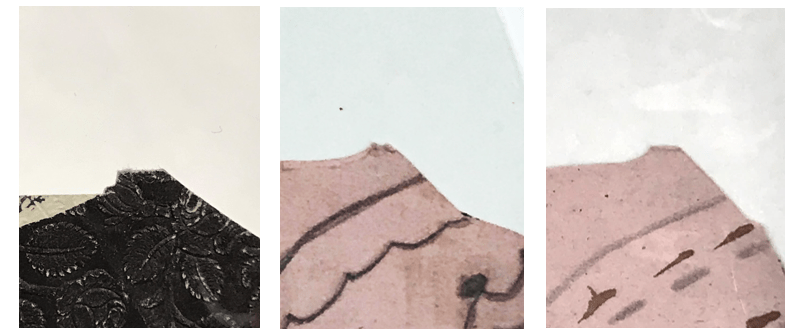Handmade Paper Dolls
Paper dolls have always been a popular toy throughout the ages. Their popularity skyrocketed as paper production became industrialized. Commercialized paper dolls were being sold as early as the 1810’s, but children also made their own handmade paper dolls, like those in Special Collections archives at the University of Chicago (Fig.1). Since paper is a fragile material, discoveries of handmade dolls are rare and exceptional. They can provide personal insight on the cultural values of their creators. As a result, through their material qualities, these handmade paper dolls provide insight on how femininity was taught in the US in the mid-1800’s.
Although it is hard to determine their date and place of creation, these paper dolls inform how young girls learned and reproduced high fashion, proper appearance, and proper behavior during this time period. These dolls were found in a 1839 edition of the New York Mirror, an important artistic magazine popular from 1830 to 1842.[1] Three of the paper doll dresses are especially worthy of attention. These 3¼ inch by 4-inch dresses are cut from a single sheet of paper, but they are folded over at the shoulders to create a double-layered dress. The black dress is made from a stiff, black, and shiny paper embossed with roses. The two pink dresses are made from a soft, pink paper (Fig. 2).[2] The interior of the black dress is cream-colored, and the interiors of the pink dresses conceal black text (Fig. 3).[3] Concerning ornamentation, the black dress has red piping and black spots drawn on it. These spots are probably wax-based pigment or crayon. Its sleeves are also decorated with cut fringe. Both the pink dresses have collar and skirt decorations penciled in. Notice that one of the pink dresses has brown-gold ink decorations that can be observed on the back of the dress (Fig. 2).[4]
The form and ornamentation of the dresses show that the creator was familiar with high fashion trends. The leg’o mutton sleeves, wide necklines, V-shaped waists, and huge skirts this young creator made were very fashionable in the 1830’s. The black ballgown is quite similar to dresses in popular fashion plates. These fashion plates can be found in Godey’s Lady’s Book, or Godey’s Magazine, a popular magazine for young ladies in this time period (Figure 4).[5] Through providing many hours of play, as seen from the worn shoulders of the little dresses (Figure 5), these paper dolls served as teaching tools for their creator. Specifically, they taught her how to express class through dress and play.
Furthermore, these dresses also taught their creator about artistic literacy. These paper dolls educated young girls in the importance of education and economy – an important part of marrying well. To illustrate, many the dolls and their clothing are made from scrap paper, including the two pink ballgowns. They contain text hinting that the pink paper used to be part of a musical program (Figure 3). Scrap paper was a valuable material for this young creator, showcasing their resourcefulness. It should be noted that while Godey’s Magazine was famous for its fashion plates, this magazine also published short stories, musical scores, and advice columns about domestic economy. Advice of all types was published, from making cheap bread[6] to saving shorn hair for making rags.[7] Though paper dolls are not directly related to running a household, they provided an opportunity for little girls to learn resourcefulness. This was especially useful if they could not afford paper dolls sold in stores. As Godey’s Magazine says, “[t]he origin of wealth is in a moral feeling… here is something I will not consume or throw away… I will store it up for the future use of myself and others.”[8] These paper dolls were motivated by this spirit of self-sufficiency in female education, not just the wish to play. The maker’s desirability as a wife and adult was directly related to how she managed her household, not just her knowledge of craft and fashion. As can be seen, these paper dolls were a part of her education in becoming a competent household manager.
It is evident that these paper dolls are not just pretty toys – they were also educational tools. They open a window to how little girls in the mid-nineteenth century learned to play, dress, learn, and manage their resources.
Figures
Figure 1: Two examples of paper dolls from Special Collections at the University of Chicago.
Figure 2: Three paper doll dresses. Top row: front and back of black dress. Middle row: front and back of dress 49. Bottom row: front and back of dress 50.
Figure 3: Interior shots of the paper dresses. Left: interior of black dress. Right: interior of dress 49.
Figure 4: Comparison between fashion plate in 1839 edition of Godey’s Magazine (left) and black paper ballgown (right). Note that ruffled leg’o mutton sleeves, floral decorations on the voluminous ruffled skirt, and wide necklines are shared between the dresses.
Figure 5: Detail shots of worn shoulder joins, where both layers of the paper dresses are connected.
References
- Paper Dolls. Collection, Box 1, Folder 1, Special Collections Research Center, University of Chicago Library.
- Paper Dolls. Collection, Box 1, Folder 4, Special Collections Research Center, University of Chicago Library.
- Ibid.
- Ibid.
- Godey’s Lady’s Book, and Ladies’ American Magazine (1840-1843), (02, 1839): 99
- Paper Dolls. Collection, Box 1, Folder 4.
- MRS, S. J. HALE. “DOMESTIC ECONOMY.: NO. I.” Godey’s Lady’s Book, and Ladies’ American Magazine (1840-1843)20, (01, 1840): 42.
- “LITTLE ECONOMIES.: THE USES OF HAIR.” Godey’s Lady’s Book and Magazine (1854-1882)52, (02, 1856): 156.
- Neal, Alice B. “THE FRUGAL HOUSEWIFE.: A CHAPTER OF DOMESTIC ECONOMY.” Godey’s Lady’s Book and Magazine (1854-1882)55, (08, 1857): 124.




